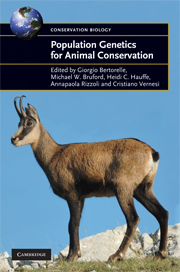Book contents
- Frontmatter
- Epigraph
- Contents
- List of contributors
- Foreword
- Acknowledgements
- 1 Introduction
- Statistical approaches, data analysis and inference
- Molecular approaches and applications
- 6 Challenges in assessing adaptive genetic diversity: overview of methods and empirical illustrations
- 7 Monitoring and detecting translocations using genetic data
- 8 Non-invasive genetic analysis in conservation
- 9 The role of ancient DNA in conservation biology
- From genetic data to practical management: issues and case studies
- Future directions in conservation genetics
- Software index
- Species index (common name)
- Species index (Latin name)
- Subject index
9 - The role of ancient DNA in conservation biology
from Molecular approaches and applications
Published online by Cambridge University Press: 05 July 2015
- Frontmatter
- Epigraph
- Contents
- List of contributors
- Foreword
- Acknowledgements
- 1 Introduction
- Statistical approaches, data analysis and inference
- Molecular approaches and applications
- 6 Challenges in assessing adaptive genetic diversity: overview of methods and empirical illustrations
- 7 Monitoring and detecting translocations using genetic data
- 8 Non-invasive genetic analysis in conservation
- 9 The role of ancient DNA in conservation biology
- From genetic data to practical management: issues and case studies
- Future directions in conservation genetics
- Software index
- Species index (common name)
- Species index (Latin name)
- Subject index
Summary
INTRODUCTION
A central goal of conservation is the maintenance of ecosystems, species or populations at their current state, or the restoration of biological systems to some former state. In cases of recent ecological collapse, such as the decline of a population due to the introduction of disease or an invasive competitor, or due to over-hunting or habitat destruction, we may have monitored the process from start to finish and the former state may be sufficiently well-described to give us a target for restoration. In most cases, though, serious monitoring only begins after a decline is identified, and only anecdotal evidence is available to guide our reconstruction of the past. In addition, the mechanisms that have driven changes in ecosystems are typically unknown. Are these changes the result of natural processes acting over many millennia, or has human activity drastically altered the natural trajectory? The recent application of genetics to conservation has allowed us to describe more fully the current status of populations by quantifying such properties as levels of inbreeding, effective population sizes, levels of genetic variation, and gene flow (Fleischer 1998; DeSalle and Amato 2004). Through the application of coalescent models, population genetics has also given us insight into the historical status of populations, whether such properties as size and growth of a population have changed and on what time scale these changes have occurred. Unfortunately, the stochastic nature of the coalescent process and the effects of selection often impair our ability to confidently reconstruct historical states. With the relatively recent development of ancient DNA (aDNA) techniques, however, we can now step directly backwards in time to characterize historical genetic diversity and to better understand the processes that have generated current levels of genetic diversity and population structure. Our ability to travel back in time using aDNA has allowed us to view conservation issues with a broader temporal perspective and has provided a better framework for understanding the impact of humans in shaping contemporary animal populations.
- Type
- Chapter
- Information
- Population Genetics for Animal Conservation , pp. 202 - 224Publisher: Cambridge University PressPrint publication year: 2009



